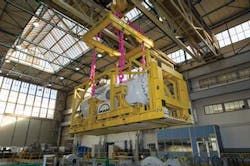Subsea processing retains innovation, moves toward standardization
Larry Forster
Mac McKee
John Allen
INTECSEA
This issue ofOffshore contains the 2014 Worldwide Survey of Subsea Processing Systems, the seventh installment of this industry resource, a joint effort between INTECSEA and Offshore magazine. The primary aims of this poster are to chronicle the development and the developers of these systems, and to document the continued commitment of oil companies to the application of these technologies. For online access to view and download all seven posters, please visit www.offshore-mag.com/maps-posters.html.
Each year's edition of the poster reflects the evolution of the technology, and is also an evolution in itself in the way the information is presented. This year, we have noted a distinct trend: subsea boosting is more a matter of course for many operators, and efforts have shifted toward effective implementation. The formation of API Committee 17X, charged with development of a Recommended Practice for Subsea Pumping within the next year, is evidence of the focus on effective implementation, and also marks the beginnings of standardization in thesubsea processing arena. While we have worked each year to graphically illustrate the various subsea processing architectures and their respective applications, this year we have revised our approach to further capture this trend toward implementation, even while the key technologies continue to evolve.
Subsea configurations
Subsea processing configurations, a newly revised section this year, is in the lower right-hand quadrant of the poster. In this section, there are three graphical system configurations, titled short, medium and long distance configuration examples. These diagrams capture the basic elements of subsea processing systems, and show how these systems evolve as requirements of the field under development steadily expand with increasing distance from the host platform or shore facility. We also note that the use of the various building blocks is not necessarily restricted to the short, medium or long distance examples in which we have portrayed them. There are exceptions to every rule, yet we believe we have captured the concepts in a way that will help our readers understand and apply the capabilities of the technologies.
Short distance
The short distance configuration example is in Figure 1 of the subsea processing configurations section of the poster. The single element of subsea processing in this figure is subsea boosting which, again, is becoming a matter of course for many operators. This example applies to tieback distances up to 15 km (9.3 mi). Figure 1 is accompanied by a one-line electrical diagram, Figure 2, and a process flow diagram, Figure 3, corresponding to the equipment layout of Figure 1.
Also included in the subsea processing configurations section are eight charts entitled subsea power and processing technology attributes, each showing currently qualified capabilities and those being qualified or under further development. For the short distance example, tables 4.2 and 4.3 are applicable for the electrical power system and subsea boosting technology, respectively.
Medium distance
The medium distance configuration example is in Figure 4 of the subsea processing configurations section, and the electrical one-line diagram and process flow diagrams are shown in Figures 5 and 6, respectively. Medium distance ranges up to 60 km (37.3 mi). In this range, flow assurance challenges typically present the need for gas/liquid separation (we have also included the capability for raw seawater injection). The subsea power and processing technology attributes are shown in Tables 4.4, 4.5, and 4.8 for power, two-phase separation, and raw seawater injection technology, respectively; Table 4.3 still applies for subsea boosting.
Long distance
The most challenging, and most interesting, example is the long distance configuration, in Figure 7, for distances ranging up to 140 km (87 mi). At this distance, all the major elements of subsea processing might come into play: three phase separation, produced water re-injection, and gas compression, as well as subsea boosting. The attributes are shown in Tables 4.1, 4.3, 4.6, and 4.7.
Power system step-out
One feature from the 2013 poster retained for this year is Table 5: power system step-out configurations. The Type 1, 2, and 3 categories in this table correspond to the Type 1, 2, and 3 electrical diagrams used in the short, medium and long distance configurations. The Type 4 category shown in Table 5 was not illustrated with a subsea processing configuration in this year's poster. The range for Type 4 extends up to 400 km (~250 mi), and perhaps even further. This range lies clearly in the future, beyond the projections we have made to date.
Two areas to watch
A number of technology advances are identified in the poster, each of which will be quite interesting to follow, but there are two areas worthy of special note: separator technology and gas compression. Whereas the conventional vessel technology has seen success, most notably atPazflor, concerns over cost, size and weight continue to drive interest in alternatives. Finally, we are confident that the pending installations of gas compressors at Åsgard and Gullfaks will draw special interest, and may guide the subsea processing industry closer toward a complete and comprehensive subsea capability.

